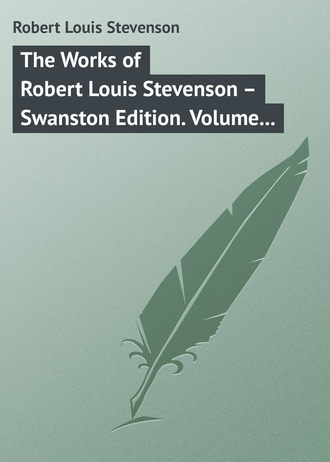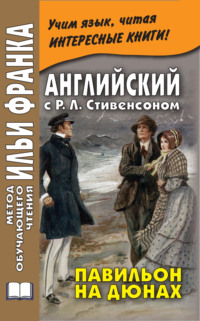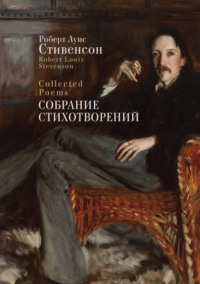 полная версия
полная версияПолная версия
The Works of Robert Louis Stevenson – Swanston Edition. Volume 14
IX
BURLESQUE SONNET
TO ÆNEAS WILLIAM MACKINTOSH
Thee, Mackintosh, artificer of light,Thee, the lone smoker hails! the student, thee;Thee, oft upon the ungovernable sea,The seaman, conscious of approaching night;Thou, with industrious fingers, hast outrightMastered that art, of other arts the key,That bids thick night before the morning flee,And lingering day retains for mortal sight.O Promethean workman, thee I hail,Thee hallowed, thee unparalleled, thee boldTo affront the reign of sleep and darkness old,Thee William, thee Æneas, thee I sing;Thee by the glimmering taper clear and pale,Of light, and light’s purveyance, hail, the king.X
THE FINE PACIFIC ISLANDS
(HEARD IN A PUBLIC-HOUSE AT ROTHERHITHE)The jolly English YellowboyIs a ’ansome coin when new,The Yankee Double-eagleIs large enough for two.O, these may do for seaport towns,For cities these may do;But the dibbs that takes the HislandsAre the dollars of Peru:O, the fine Pacific Hislands,O, the dollars of Peru!It’s there we buy the cocoanutsMast ’eaded in the blue;It’s there we trap the lassesAll waiting for the crew;It’s there we buy the trader’s rumWhat bores a seaman through…In the fine Pacific HislandsWith the dollars of Peru:In the fine Pacific HislandsWith the dollars of Peru!Now, messmates, when my watch is up,And I am quite broached to,I’ll give a tip to ’EvvingOf the ’ansome thing to do:Let ’em just refit this sailor-manAnd launch him off anewTo cruise among the HislandsWith the dollars of Peru:In the fine Pacific HislandsWith the dollars of Peru!Tahiti, August 1888.XI
AULD REEKIE
When chitterin’ cauld the day sall daw,Loud may your bonny bugles blawAnd loud your drums may beat.Hie owre the land at evenfa’Your lamps may glitter raw by raw,Along the gowsty street.I gang nae mair where ance I gaed,By Brunston, Fairmileheid, or Braid;But far frae Kirk and Tron.O still ayont the muckle sea,Still are ye dear, and dear to me,Auld Reekie, still and on!XII
THE LESSON OF THE MASTER
TO HENRY JAMESAdela, Adela, Adela Chart,What have you done to my elderly heart?Of all the ladies of paper and inkI count you the paragon, call you the pink.The word of your brother depicts you in part:“You raving maniac!” Adela Chart;But in all the asylums that cumber the ground,So delightful a maniac was ne’er to be found.I pore on you, dote on you, clasp you to heart,I laud, love, and laugh at you, Adela Chart,And thank my dear maker the while I admireThat I can be neither your husband nor sire.Your husband’s, your sire’s, were a difficult part;You’re a byway to suicide, Adela Chart;But to read of, depicted by exquisite James,O, sure you’re the flower and quintessence of dames.Vailima, October 1891.XIII
THE CONSECRATION OF BRAILLE
TO MRS. A. BAKERI was a barren tree before,I blew a quenchèd coal,I could not, on their midnight shore,The lonely blind console.A moment, lend your hand, I bringMy sheaf for you to bind,And you can teach my words to singIn the darkness of the blind.Vailima, December 1893.XIV
SONG
Light foot and tight foot,And green grass spread,Early in the morning,But hope is on ahead.Brief day and bright day,And sunset red,Early in the evening,The stars are overhead.1
“Life on the Lagoons,” by H. F. Brown, originally burned in the fire at Messrs. Kegan Paul, Trench & Co.’s.
2
From “Travels with a Donkey.”
3
page 140. “The aito,” quasi champion, or brave. One skilled in the use of some weapon, who wandered the country challenging distinguished rivals and taking part in local quarrels. It was in the natural course of his advancement to be at last employed by a chief, or king; and it would then be a part of his duties to purvey the victim for sacrifice. One of the doomed families was indicated; the aito took his weapon and went forth alone; a little behind him bearers followed with the sacrificial basket. Sometimes the victim showed fight, sometimes prevailed; more often, without doubt, he fell. But whatever body was found, the bearers indifferently took up.
4
page 141. “Pai,” “Honoura,” and “Ahupu.” Legendary persons of Tahiti, all natives of Taiárapu. Of the first two I have collected singular although imperfect legends, which I hope soon to lay before the public in another place. Of Ahupu, except in snatches of song, little memory appears to linger. She dwelt at least about Tepari, – “the sea-cliffs,” – the eastern fastness of the isle; walked by paths known only to herself upon the mountains; was courted by dangerous suitors who came swimming from adjacent islands, and defended and rescued (as I gather) by the loyalty of native fish. My anxiety to learn more of “Ahupu Vehine” became (during my stay in Taiárapu) a cause of some diversion to that mirthful people, the inhabitants.
5
page 142. “Covered an oven.” The cooking fire is made in a hole in the ground, and is then buried.
6
page 143. “Flies.” This is perhaps an anachronism. Even speaking of to-day in Tahiti, the phrase would have to be understood as referring mainly to mosquitoes, and these only in watered valleys with close woods, such as I suppose to form the surroundings of Rahéro’s homestead. A quarter of a mile away, where the air moves freely, you shall look in vain for one.
7
page 144. “Hook” of mother-of-pearl. Bright-hook fishing, and that with the spear, appear to be the favourite native methods.
8
page 145. “Leaves,” the plates of Tahiti.
9
page 146. “Yottowas,” so spelt for convenience of pronunciation, quasi Tacksmen in the Scottish Highlands. The organisation of eight sub-districts and eight yottowas to a division, which was in use (until yesterday) among the Tevas, I have attributed without authority to the next clan (see page 155).
10
page 146. “Omare,” pronounce as a dactyl. A loaded quarterstaff, one of the two favourite weapons of the Tahitian brave; the javelin, or casting spear, was the other.
11
page 148. “The ribbon of light.” Still to be seen (and heard) spinning from one marae to another on Tahiti; or so I have it upon evidence that would rejoice the Psychical Society.
12
page 149. “Námunu-úra.” The complete name is Námunu-úra te aropa. Why it should be pronounced Námunu, dactylically, I cannot see, but so I have always heard it. This was the clan immediately beyond the Tevas on the south coast of the island. At the date of the tale the clan organisation must have been very weak. There is no particular mention of Támatéa’s mother going to Papara, to the head chief of her own clan, which would appear her natural recourse. On the other hand, she seems to have visited various lesser chiefs among the Tevas, and these to have excused themselves solely on the danger of the enterprise. The broad distinction here drawn between Nateva and Námunu-úra is therefore not impossibly anachronistic.
13
page 149. “Hiopa the king.” Hiopa was really the name of the king (chief) of Vaiau; but I could never learn that of the king of Paea – pronounce to rhyme with the Indian ayah– and I gave the name where it was most needed. This note must appear otiose indeed to readers who have never heard of either of these two gentlemen; and perhaps there is only one person in the world capable at once of reading my verses and spying the inaccuracy. For him, for Mr. Tati Salmon, hereditary high chief of the Tevas, the note is solely written: a small attention from a clansman to his chief.
14
page 150. “Let the pigs be tapu.” It is impossible to explain tapu in a note; we have it as an English word, taboo. Suffice it, that a thing which was tapu must not be touched, nor a place that was tapu visited.
15
page 155. “Fish, the food of desire.” There is a special word in the Tahitian language to signify hungering after fish. I may remark that here is one of my chief difficulties about the whole story. How did king, commons, women, and all come to eat together at this feast? But it troubled none of my numerous authorities; so there must certainly be some natural explanation.
16
page 160. “The mustering word of the clan.”
Teva te ua,Teva te matai!Teva the wind,Teva the rain!17
page 165. “The star of the dead.” Venus as a morning star. I have collected much curious evidence as to this belief. The dead retain their taste for a fish diet, enter into copartnery with living fishers, and haunt the reef and the lagoon. The conclusion attributed to the nameless lady of the legend would be reached to-day, under the like circumstances, by ninety per cent. of Polynesians: and here I probably under-state by one-tenth.
18
page 165. “The star of the dead.” Venus as a morning star. I have collected much curious evidence as to this belief. The dead retain their taste for a fish diet, enter into copartnery with living fishers, and haunt the reef and the lagoon. The conclusion attributed to the nameless lady of the legend would be reached to-day, under the like circumstances, by ninety per cent. of Polynesians: and here I probably under-state by one-tenth.
19
page 169. “Pit of popoi.” Where the bread-fruit was stored for preservation.
20
page 169. “Ruby-red.” The priest’s eyes were probably red from the abuse of kava. His beard (ib.) is said to be worth an estate; for the beards of old men are the favourite head-adornment of the Marquesans, as the hair of women formed their most costly girdle. The former, among this generally beardless and short-lived people, fetch to-day considerable sums.
21
page 169. “Tikis.” The tiki is an ugly image hewn out of wood or stone.
22
page 172. “The one-stringed harp.” Usually employed for serenades.
23
page 173. “The sacred cabin of palm.” Which, however, no woman could approach. I do not know where women were tattooed; probably in the common house, or in the bush, for a woman was a creature of small account. I must guard the reader against supposing Taheia was at all disfigured; the art of the Marquesan tattooer is extreme; and she would appear to be clothed in a web of lace, inimitably delicate, exquisite in pattern, and of a bluish hue that at once contrasts and harmonises with the warm pigment of the native skin. It would be hard to find a woman more becomingly adorned than “a well-tattooed” Marquesan.
24
page 175. “The horror of night.” The Polynesian fear of ghosts and of the dark has been already referred to. Their life is beleaguered by the dead.
25
page 176. “The quiet passage of souls.” So, I am told, the natives explain the sound of a little wind passing overhead unfelt.
26
page 178. “The first of the victims fell.” Without doubt, this whole scene is untrue to fact. The victims were disposed of privately and some time before. And indeed I am far from claiming the credit of any high degree of accuracy for this ballad. Even in the time of famine, it is probable that Marquesan life went far more gaily than is here represented. But the melancholy of to-day lies on the writer’s mind.
27
page 191. Mr. Nutt reminds me it was “by my sword and Ben Cruachan” the Cameron swore.
28
page 194. “A periwig’d lord of London.” The first Pitt.
29
page 195. “Cathay.” There must be some omission in General Stewart’s charming “History of the Highland Regiments,” a book that might well be republished and continued; or it scarce appears how our friend could have got to China.
30
This is the same Princess Moë whose charms of person and disposition have been recorded by the late Lord Pembroke in “South Sea Bubbles,” and by M. Pierre Loti in the “Mariage de Loti.”
31
The yacht Casco had been so called by the people of Fakarava in Tahiti.
32
“The whole front of the house was lighted, and there were pipes and fiddles, and as much dancing and deray within as used to be in Sir Robert’s house at Pace and Yule, and such high seasons.” – See “Wandering Willie’s Tale” in “Redgauntlet,” borrowed perhaps from “Christ’s Kirk of the Green.”
33
In architecture, a series of piles to defend the pier of a bridge.











